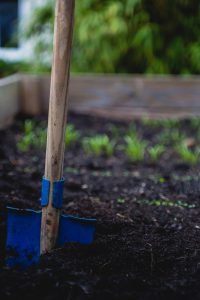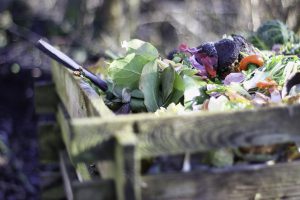Many years ago, when my daughter was in middle school, she bought an interesting gift for my birthday that perhaps only a child of an Extension agent would purchase – worm castings! What made the gift thoughtful is that I actually possessed in my kitchen at the time a gray plastic bin of red wiggler worms (Eisenia foedita) composting my food scraps. That lovely gift was included in transplanted container plantings which thrived from the addition.
Composting Basics

Composting is a way to recycle yard waste – nitrogen rich “greens” such as grass clippings combined with carbon rich “browns” such as leaves, and perhaps additional food scraps (greens) buried deep in the pile and water resulting in brown, crumbly compost over time. Ideally you want to create a compost that has a Carbon:Nitrogen ratio of 30:1 – ultimately more leaves than greens. To start a pile, you will begin with equal alternating amounts of browns and greens, like making lasagna. You can add a little water as you go, but do not want to saturate the pile. Don’t add meats and fats to your compost bin, but vegetable food scraps, peelings, coffee grounds, tea bags, oatmeal or other cereals without fat. Bury those appropriate edibles deeper in your compost pile to discourage

rodents and other animals from visiting.
You can compost in just one pile or bin, or create a three-bin system where stages of composting are moved from bin to bin where the last bin represents great, ready-to-use compost.
Your pile will initially heat up rapidly and you should turn it as the temperature cools so it can heat up again. Make sure to turn your pile and check its temperature with a thermometer so you can reach ideally 122 to 131 degrees F. If your compost pile temperature gets to be above 149 degrees F, turn it more frequently so you don’t lose the microorganisms doing the composting work for you.
Using Compost
Compost is a wonderful addition that improves the structure not only to our sandy soils in Central Florida but also clay soils. You can add 1-3 inches on top of the soil surface and mix it to a depth of 4-6 inches in planting beds. You can also top dress your lawns with compost or use it in potting mixes. Don’t incorporate compost to soils when you plant one tree or shrub, but use existing soil only. Then, top dress with your lovely, brown compost under mulch up to the root ball. Adad compost when planting an entire bed of plants or a vegetable garden.
Vermicomposting
If, perhaps, you don’t have room for a traditional compost bin, vermicomposting may be for you! Worms in a bin, are able to break down materials from your kitchen such as vegetable peelings, oatmeal, and coffee grounds. Red Wigglers are unable to break down fats or meats which also should not be added to a traditional compost bin.

Vermicomposting bins are easy to make. Start with a 13-gallon plastic bin, with holes drilled in the top and along the top side. Rip up thin sections of newspaper enough to fill the bin, place in plastic bag, add water to get moist, but not saturated. Place the moistened newspaper in the bin, sprinkle in a handful of soil from your garden, mix and then add one-half to one pound of red wiggler worms which can be ordered online. Also, if you do not feel like creating your own bin, they do make worm “hotels,” which you can purchase.
Will the worms escape? If you feed them, they will stay! After are added to the bin, they will crawl to the bottom of the bin. You can use a small garden fork to move some of the newspaper aside and add a bit of your kitchen waste, and then slide the newspaper back. The worms will then move back and forth as you add scraps. They also will break down the newspaper, ultimately creating worm castings or compost. When things look really decomposed, you can take your bin and tip it upside down on a tarp. The worms will crawl to the bottom and you can harvest the compost on top and start over again with new newspaper. Use vermicompost the same way you would traditional compost.
For more information on creating compost in your yard, read UF/IFAS publication, Compost Tips for the Home Gardener, at http://edis.ifas.ufl.edu/ep323.
 0
0
